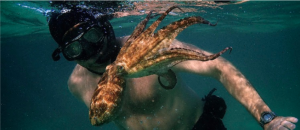
Review by Brad Balfour
My Octopus Teacher
Directors: Pippa Ehrlich, James Reed
Subject: Craig Foster, Octopus
Few creatures are as alien to us as an octopus. These eight-tentacled creatures lack bones and a spinal column, they can shoot jets of black ink for defense, they fool their prey through their own biological camouflage and they hardly make a sound. Yet, as the Netflix film My Octopus Teacher demonstrates, all things are possible with a young octopus if you are patient and understanding enough.
As snorkeler/naturalist Craig Foster revealed in this full-length feature, there’s lots of adventures to be had with a local octopus which were, thankfully, copiously documented almost daily over a year-long period. In 2010, Foster began free-diving in an underwater kelp forest at a remote location in False Bay, near Cape Town, South Africa which is close to Simon’s Town on the Cape Peninsula, an area exposed to the Atlantic Ocean’s cold Benguela current. As he documented his experiences, he met a curious young female that captured his attention. He kept visiting her den and tracking her movements to win the animal’s trust. The two formed a bond where she plays with Foster and allows him into her world to see how she sleeps, lives, and eats. In the film, Foster describes the impact on his life.
As he eventually wins the creature’s trust, it finally extends a tentacle to him and caresses his arm and hand with its suction cups. He is able to gain enough trust that he observes it in its natural environment among the kelp forest. During that year, the native South African spent hours as the octopus’ companion, watching it act in accord with its environment, generally disregarding his presence — and, in a way, appreciating it throughout its limited lifespan.
Thanks to co-directors Pippa Ehrlich and Reed who interviewed Foster and lent his work a narrative thread, Foster’s many hours of documentation shot during that time didn’t remain locked away in some drawer. Over the last 10 years, this trio has been trying to complete this film and get it out there for the public to see. They did indeed succeed and garnered much positive reaction as a result.
 This is much more than the standard nature film. Maybe it’s because Foster didn’t really shoot his footage — he let it happen. As illustrated in the film, he laid a camera down on the sea and let it record whatever happened. Foster describes the effect of this mentorship as teaching him a lesson on the fragility of life and humanity’s connection with nature. This even transformed Foster’s bond with his son as his son develops as a diver and marine life student.
This is much more than the standard nature film. Maybe it’s because Foster didn’t really shoot his footage — he let it happen. As illustrated in the film, he laid a camera down on the sea and let it record whatever happened. Foster describes the effect of this mentorship as teaching him a lesson on the fragility of life and humanity’s connection with nature. This even transformed Foster’s bond with his son as his son develops as a diver and marine life student.
Ultimately, this led to the Oscar for Best Documentary Feature this year. If any film illustrates the way to make a documentary that has a natural story arc, an emotional impact and beautiful imagery, this is the one to see.
